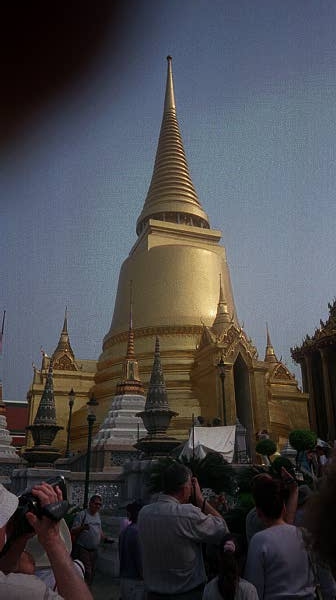

This trip came about in kind of an ironic manner. Over lunch I was discussing possible destinations for a winter vacation with my friends and co-workers. I stated what I wanted was to go somewhere in Asia, take a cruise on a small ship, and have some heat and sun. Not too much to ask, right? Well, as fate would have it, that day a brochure came from Grand Circle Travel that was tailor made for my requirements. Four days in Bangkok, two days in Singapore and a seven day cruise on a sailing ship with a capacity of 170 guests. There was also an optional tour prior to the trip which extended my time in Bangkok by two days, and a post-trip option to visit Hong Kong for two days. As long as I was already there, I figured I might as well "see it all," so the trip ended up being nearly three weeks. I was pleasantly surprised when my mother consented to join me in this adventure. Due to the popularity of the trip, we had to book it over a year in advance, so until I was sitting on a plane, it didn't seem real.
The first leg of the trip took us to Narita airport, in Japan, where we were supposed connect with another flight that would take us onto Bangkok. After thirteen hours on an over-booked flight, we arrived in Japan only to find the airport had been closed for some emergency. We circled for a while, but eventually had to be diverted to another airport to refuel. What a nightmare that was! Every plane scheduled to land at Narita had to be diverted, and most needed refueling. Because of the backlog, we ended up remaining on the plane another three hours before we actually made it back to Narita. Needless to say we missed our connecting flight. But, it all worked out for the best when we were put up in a very nice hotel, giving us a chance to catch up on some of our sleep. We missed a day in Bangkok, but I think I was more grateful for the rest!
Our first day in Bangkok began with a tour of the waterfront and canals, or klongs. the Chao Phraya river divides what is considered Bangkok into two parts. Thonburi on one side, was the site of the third Capital of Thailand, before it was moved across the river to Bangkok. Incidentally, the Thai people refer to their city as Krung Thep, "City of Angels," it's the rest of the world that still calls the city "Bangkok." The name comes from two Thai words "Bang" meaning "village" and "kok" which is a type of plum. Thailand was also once known as Siam, but this was a foreign word as well, and the people changed the name of their country to "Thailand" which means "land of the free," as they had never been totally conquered.

I was a bit surprised by the extensive canal network that exists not only Bangkok but other villages as well. Our guide told us it was the "Venice of the Orient," and I can see why. Many people live along the klongs, using the waterways as streets. There was even electrical poles running down the center of the canals. The further we were from the city, the more agricultural in nature the homesteads became. The majority of the population is still farmers, but those numbers dwindle yearly. As it is now, farmers raise their crops and take them into the city by boat to sell to the markets. A tradition that is centuries old.

Our next stop that day was at Wat Arun, site of the third capital on the Thonburi side of the river. Wat Arun means "Temple of The Dawn" and was named because the current king stopped there at dawn, declaring the site his new capital.

The temple is in the style of the Khmer people, ancient inhabitants of Cambodia, and is one of many styles of temples found throughout Bangkok. The "mosaics" on the cement face of the temple are actually china plates that were broken and attached in a pattern. The amount of workmanship that goes into the building of the temples is staggering.

The Royal Palace is now used only for ceremonial purposes, but was once the home of the kings of the Chakri dynasty. King Mongut (Rama IV) is the monarch depicted in the movies "The King and I," and "Anna and The King." His son (the Crown Prince in the movies) was Chulalongkorn (Rama V), and it was during his reign Thailand came into step with the rest of the world. The current king, Bhumibol Adulyadej, is the ninth monarch in the dynasty, and highly revered. Since the 1930's Thailand has had a representative government, but the King still plays an important roll in the lives of the people. One fact I found interesting was the current king was born in Boston while his mother was touring the U.S.! These are some pictures from inside the gates of the Royal Palace.


It was very crowded and hot that day, so I missed most of the commentary on what function the buildings serve. However, I did learn that the model of Ankor Wat, from Cambodia is to commemorate King Mongut's ambition to have the entire Wat moved to Thailand. Needless to say, he didn't accomplish his goal.

